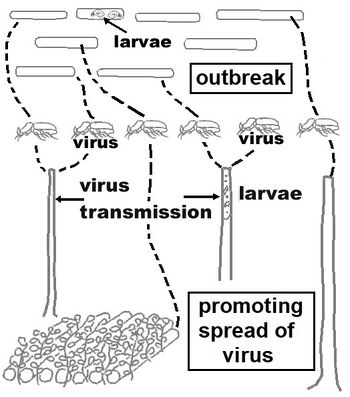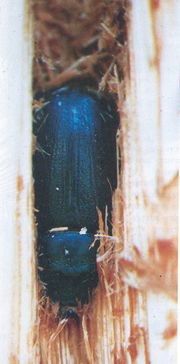Oryctes rhinoceros
| Literature database |
|---|
| 76 articles sorted by: |
| • year (recent ones first) |
| • research topics |
| • countries/regions |
| • host plants |
| • list of natural enemies |
Oryctes rhinoceros (Linnaeus) (coconut rhinoceros beetle)
This horned dynastid beetle is an important pest of coconut and oil palms in tropical parts of Asia and the Pacific. It is endemic in an area stretching from India and Pakistan in the west to Taiwan and the Philippines in the east, as well as Indonesia in the south. Since around 1910, this distribution has expanded, mostly through human activities, to include various additional islands in the Pacific and the Indian Ocean (e.g. see Catley, 1969). For example, around 1910, larvae of O. rhinoceros were accidentally introduced into Samoa from Sri Lanka with rubber seedlings. From there, the beetle spread to neighbouring Pacific islands like Fiji, Tonga and the Tokelau Islands. More recent introductions have been reported from Guam, Hawaii and the Solomon Islands (e.g. see Marshall et al., 2017).
Contents

Source: cropped Wikimedia Commons image
Damage
The most common host plant of the adult beetle is the coconut palm. Oil palms, introduced into southern Asia from Africa, are also often seriously damaged. Other types of palms may be occasionally attacked. The adult beetle flies up to the crown of a palm and bores a tunnel starting in the axil of a younger frond directed first inwards and then downwards. It eventually reaches the heart of the palm where the young fronds develop. In this part, the developing fronds are still white and densely packed together. The beetle feeds on them and typically damages 3-4 fronds during an attack. If a frond is damaged at the base, it often breaks off when it is mature and starts to unfold. If only the leaflets are damaged, the unfolding frond shows characteristic triangular cuts. Attacks to newly planted palms, e.g. 2-3 years after planting, often result in the death of the palm, because the beetle can destroy the growing point during feeding.
The cut fronds are clearly visible from the ground and can be fairly accurately counted using a binocular. Such counts give an indicator for the number of beetles in a given area if they are adjusted for the density of palms. In ecological studies, such "cuts-per-hectare" estimates are a useful measure for the O. rhinoceros density in an area. Moreover, population changes can be measured by recording the position of the cuts on the crown. A coconut palm produces a new frond every 3-4 weeks and the location of the damaged fronds in the crown as well as the position of the cuts on the fronds correlates to the time of the attacks (e.g. see Zelazny & Alfiler, 1987). For approximate estimates on the population dynamics, the cuts on lower (older) and upper (younger) fronds are counted from the ground and compared. For more accurate estimates, palms are climbed for determining the sequence of fronds and the position of the cuts on each frond.
Breeding and outbreaks
After several days of feeding inside a palm, the beetle leaves the palm and searches for a breeding place. The preferred breeding places are the trunks of dead coconut palms. However, trunks of oil palms and various other types of decaying wood are also used. The latter includes, for example, stumps of rubber trees and their roots as well as sawdust heaps near sawmills. The wood has to have reached the right stage of decay to be a suitable food for the larvae. Both, freshly felled coconut trunks as well as too rotten trunks are not used for breeding. The female lays a batch of several dozen eggs inside the trunk and the hatching larvae feed on the decaying wood going through 3 instars and finally pupating in the breeding site. The whole development takes around half a year and young beetles leave the breeding site flying to a close-by palm for feeding.
| Vernacular names | |
|---|---|
| • Deutsch: | Indischer Nashornkäfer |
| • English: | coconut rhinoceros beetle (CRB) Indian rhinoceros beetle Asiatic rhinoceros beetle |
| • Español: | escarabajo rinoceronte Asiático |
| • Français: | rhinoceros du cocotier |
Obviously, the beetle has evolved breeding in coconut palms which died naturally of old age. Such a "dead-standing" coconut palm starts rotting from the top and is used by O. rhinoceros as a breeding site for many years. Within its distribution range, O. rhinoceros larvae can be found in most dead-standing palms. In plantations, coconut and oil palms rarely die of old age, but are felled when they become unproductive, e.g. at an age of around 70 years for tall coconut varieties. The trunks and the stumps of felled palms are also readily accepted for breeding by O.rhinoceros when they have reached the right stage of decay and are not hidden by overgrown vegetation. As a result, the replanting of a coconut or oil palm plantation often triggers a serious beetle outbreak, because of the combination of an abundance of breeding places and the higher vulnerabilty of the newly planted young palms.
Natural enemies
Apart from some predators and parasitoids like Scolia wasps which are minor contributors to the natural mortality of the larvae, there are two diseases which affect O. rhinoceros. The fungus Metarhizium majus (previously considered a form of Metarhizium anisopliae) and a virus disease caused by the Oryctes rhinoceros nudivirus. The fungus is naturally present wherever O. rhinoceros is found. However, it only affects a small percentage of the larvae and rarely kills adult beetles.
The virus disease usually has the most significant impact on the O. rhinoceros population. It was discovered in 1963 by Alois M. Huger in Malaysia and is naturally present in the native distribution area of the beetle, from India to the Philippines and to Indonesia. It infects adults as well as larvae and spreads easily between both. However, it is not transmitted through the pupal or the egg stages. The introduction of the virus into Samoa in the 1960s caused a disease epizootic in the O. rhinoceros population with a corresponding decline of the palm damage. Around 1970, about 30-40% of the adult beetles examined in Samoa were found to be infected by the virus (Zelazny, 1973).

Author: Bob Macfarlane
Source: Open Media
The virus was subsequently introduced into other virus-free O. rhinoceros populations like most Pacific islands and the Maldives, again causing similar declines of the beetle populations. For a summary on the virus see Huger (2005). However, while the virus is the most important natural control agent, its presence cannot prevent beetle outbreaks during the replanting of coconut or oil palm plantations because virus transmission is suppressed under such conditions. Moreover, some beetle populations have shown to be resistant to the virus. For example in Guam where O. rhinoceros was first recorded in 2007, a new haplotype (CRB-G) has been described with a high level of resistance to the virus (Marshall et al., 2017).
Management (1. cultural control)
Management options for O. rhinoceros are limited and a relatively low density of beetles in a plantation can cause serious damage. There are few possibilities of targeting the adult beetles directly. In some oil palm plantations of Indonesia, workers check recently planted oil palms daily for fresh beetle attacks and remove the adults. This is very labour intensive and it is not clear to what extend this practice prevents attacks. The most common approaches are the elimination of breeding places as well as promoting the Oryctes virus and Metarhizium.
Serious O. rhinoceros damage is always associated with the nearby presence of abundant breeding places. Therefore, these breeding site are the main targets of any management efforts. Often, attempts are made to burn the trunks, but this is rarely possible with coconut and oil palm trunks in the tropics. The results of most attempts are that the logs are only charred on the outside and still remain suitable for breeding by Oryctes. In addition, attempts in Indonesia to burn logs on a large scale after pouring fuel on them has created disastrous air pollution problems.
More promising are attempts to "hide" the breeeding sites from the beetles by encouraging vegetation to grow over the palm trunks. For example, in modern coconut and oil palm plantations, the establishment of a cover crop on the ground is recommended anyway to add nitrogen to the soil. For this, the climbing and fast growing vine Pueraria (kudzu) is often used. These vines are very suitable to hide coconut and oil palm trunks from Oryctes and at the same time accelerate the decay of the logs. The vines will quickly grow over shallow piles of logs if the trunks have to be moved to one part of the plantation to clear the way for farm vehicles.
Management (2. use of diseases)

• Above the beetles are 8 exposed coconut trunks lying on the ground, one of them with larvae. Because of the abundance of possible breeding places there is no contact between the infected and healthy beetles or the larvae and no virus transmission. O. rhinoceros breeding is accelerated and an outbreak will develop.
• In the lower part is a shallow pile of coconut trunks hidden from the beetles by cover crop and 3 dead-standing palms (one with larvae). The dead-standing palms are the preferred breeding sites and there is frequent contact between the beetles and therefore virus transmission. Breeding is reduced.
The fungus disease Metarhizium majus is an effective biological control agent against scarab larvae and is naturally present in all areas where Oryctes occurs. Once it has spread to a coconut trunk occupied by O.rhinoceros it will kill most larvae and then also persist in the log for several years and protect it from further breeding. However, the fungus does not spread easily by natural means to other breeding sites. During a survey in the Philippines (Zelazny and Alfiler, 1986) only 4% of the coconut trunks and stumps used by O. rhinoceros for breeding were found to contain the fungus. There have been attempts in several countries to manually introduce the fungus into Oryctes breeding sites. However, this is rather labour-intensive and its effect on the beetle population is not clear.
The introductions of the Oryctes rhinoceros nudivirus into virus-free populations have demonstrated that it is the most important natural control agent. It spreads easily within a beetle population when infected beetles visit coconut palms and breeding sites and come in contact with healthy beetles and larvae. The virus is naturally present or has been introduced into most O. rhinoceros populations, e.g. by releasing virus-infected adult beetles. However, there is evidence of resistance to the virus in some beetle populations (e.g. Marshall et al., 2017) and outbreaks can still develop during replanting situations.
The spread of the virus is suppressed when coconut and oil palm plantations are replanted and large numbers of suitable breeding places become available. There is simply not enough contact between the beetles for transmitting the disease. This is illustrated in the diagram on the right and is explained in more details on the page covering the Oryctes virus.
From the ecology of the beetle and its virus disease, it has been recommended to focus control efforts in replanting situations on:
- Promoting the establishment of climbing vines like Pueraria around coconut trunks after the old palms have been felled, in order to hide the logs from beetles searching for breeding sites.
- Leaving a few dead standing palms (about 5 per hectare) in the area to be replanted, in order to promote the spread of the Oryctes virus among the adult beetles. This option does not apply to beetle populations free from the virus, or with a high degree of resistance to the disease.

